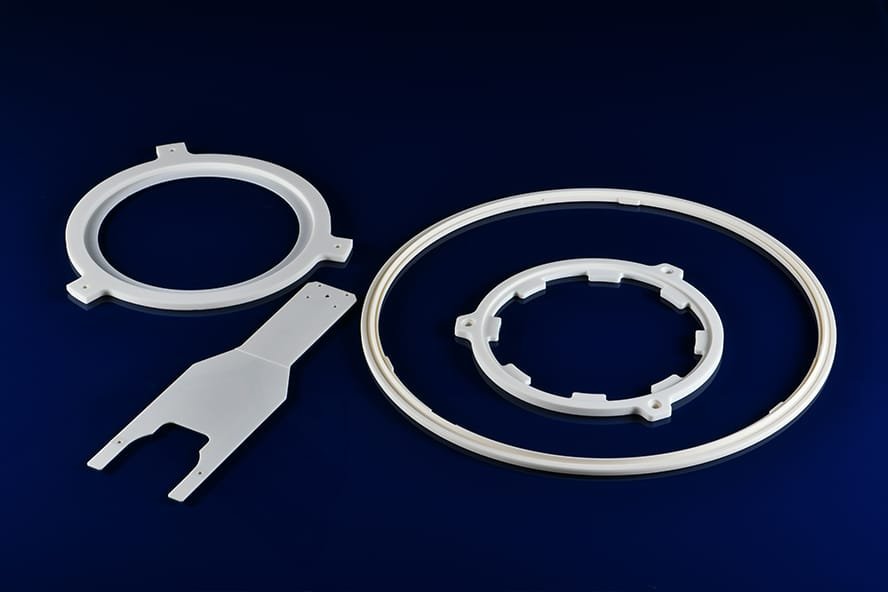アルミナセラミック 95-99.8%
成形、円形、曲面のセラミック部品の精密加工が可能
広く使用されている工業用セラミックとして、その純度は90%からそれ以上の範囲にある。 99.8%.耐久性の高い素材である。純度が高いほど優れた性能を発揮する。高い硬度、耐摩耗性、耐薬品性を持つ。半導体、医療、オートメーションなどの分野に適している。

アルミナの利点
- 優れた生体適合性
- 強力な電気絶縁特性
- 高い耐薬品性。
- 優れた高温安定性と耐熱衝撃性
- モース硬度は最大9で、高い硬度と機械的強度を持つ。
- 大きな機械的負荷に耐える
- 低熱膨張率および比熱伝導率
- 優れた熱伝導性と酸化防止性能
- 耐摩耗性
- マイクロ波電波を透過する
- 高い圧縮強度と絶縁耐力
アルミナ用途
- 機材ライニング
- 高電圧絶縁体
- 人工関節、歯科インプラント
- イグナイター絶縁体
- バルブシール、ケミカルポンプ
- 高温サポート構造
- レーザー光学部品
- 機械装置のシールリング
- 電子部品・基板
- 高温電気絶縁体
- 高圧碍子
- レーザー管
- 機械部品
- メカニカルシール
- 高摩耗環境における精密シャフトとアクスル
- ローラーとボールベアリング
- シールリング
- 半導体部品
- ショットブラストノズル
- 熱電対チューブ
- タッププレート
- バルブシート
- 摩耗部品
99.8%アルミナ材料特性
機械的特性
| プロパティ | 単位 | アルミナ |
| 密度 | g/cm³ | 3.93 |
| ビッカース硬度 | GPa | 18 |
| 曲げ強度 | MPa | 416 |
| 圧縮強度 | MPa | 2556 |
| 吸水率 | % | 0 |
| アルミナ含有量 | % | 99.8 |
| ヤング率 | GPa | 358 |
熱性能
| プロパティ | 単位 | アルミナ |
| 熱伝導率 | W/mK | 30.8 |
| 耐熱衝撃強度 | J/m²-K | 2700 |
| 最高使用温度 | °C | 1765 |
電気的特性
| プロパティ | 単位 | アルミナ |
| 誘電率 (1 MHz) | - | 9.28 |
| 電気の強さ | KV/mm | 14.7 |
| 体積抵抗率 | Ω・cm | 2.7×10¹⁴ |
注:この値は参考値であり、バッチ条件により多少異なる場合がある。
アルミナの加工
アルミナ は、通常90%から99.9%までの様々な純度で入手可能であり、Jundro Ceramicsは99.8%純度の材料を専門としている。
この材料は、射出成形、ダイ・プレス、静水圧プレス、スリップ・キャスティング、押出成形など、いくつかの方法で加工することができる。さらに、アルミナは、メタライジングやろう付けプロセスを使って、金属や他のセラミックと効果的に接合することができる。
ジュンドロ・セラミックスはプロフェッショナル アルミナセラミックスメーカー当社は、高精度で複雑な技術を専門としています。 アルミナ加工 部品.4軸および5軸マシニングセンター、ドリル、研削、フライス、研磨、鋸引き、タッピング、ねじ切り、旋盤加工などの幅広い社内能力により、厳しい仕様を満たす最高品質のアルミナ部品を保証します。
5軸アルミナセラミック加工
よくある質問
ジュンドロ・セラミックスは、以下のような複数の高純度アルミナ・グレードを供給している:
95%、99%、99.5%、99.7%、99.8% Al₂O₃。.
これらのグレードは、工業用構造部品から半導体、航空宇宙、高真空部品までの用途をカバーしている。.
純度の高いアルミナを提供する:
より高い硬度と強度
より優れた耐薬品性
より高い絶縁耐力
気孔率の低下と表面仕上げの向上
95%アルミナは、一般工業部品に適しています。 99%+アルミナ は、優れた絶縁性と機械的安定性を必要とする半導体、真空、精密用途に適している。.
そうだ。. ジュンドロ・セラミックス は、アルミナセラミックの専門メーカーです。 精密加工.
に使用される特注アルミナ部品をサポートする。 半導体装置、オートメーションシステム、航空宇宙部品、真空ツール、高温アプリケーション.
サービスには、CNCフライス加工、研削、研磨、スロット加工、ドリル加工、複雑形状加工が含まれる。.
アルミナ(Al₂O₃):
より高い硬度
より高い耐熱性
より優れた電気絶縁性
より費用対効果の高い
ジルコニアより脆い
ジルコニア(ZrO₂):
高い靭性と耐破壊性
より優れた衝撃強度
より低い熱伝導率
靭性が要求される摩耗部品に適している
アルミナ = より硬く、温度安定性が高い。ジルコニア = より硬く、耐衝撃性が高い。.
典型的なビッカース硬度(HV):
95%アルミナ: ~13.7 GPa
99%アルミナ: ~15.2 GPa
99.7%アルミナ: ~17.2 GPa
99.8%アルミナ: ~18 GPa
純度が高いほど硬度が高く、耐摩耗性に優れる。.
